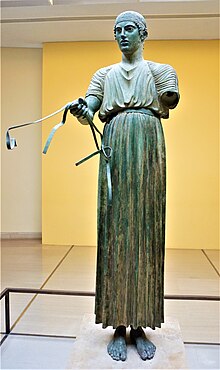
Back الأزياء في اليونان القديمة Arabic Indumentària de l'antiga Grècia Catalan Oděv v antickém Řecku Czech Ένδυση στην αρχαία Ελλάδα Greek Indumentaria en la Antigua Grecia Spanish پوشاک یونان باستان Persian Ókori görög öltözködés Hungarian Busana di Yunani kuno ID Abbigliamento nell'antica Grecia Italian 古代ギリシアの服飾 Japanese
This article needs additional citations for verification. (February 2019) |

Clothing in ancient Greece refers to clothing starting from the Aegean bronze age (3000 BCE) to the Hellenistic period (31 BCE).[1] Clothing in ancient Greece included a wide variety of styles but primarily consisted of the chiton, peplos, himation, and chlamys.[2] Ancient Greek civilians typically wore two pieces of clothing draped about the body: an undergarment (χιτών : chitōn or πέπλος : péplos) and a cloak (ἱμάτιον : himátion or χλαμύς : chlamýs).[3] The people of ancient Greece had many factors (political, economic, social, and cultural) that determined what they wore and when they wore it.[2]
Clothes were quite simple, draped, loose-fitting and free-flowing.[4] Customarily, clothing was homemade and cut to various lengths of rectangular linen or wool fabric with minimal cutting or sewing, and secured with ornamental clasps or pins, and a belt, or girdle (ζώνη: zōnē).[4][page needed] Pieces were generally interchangeable between men and women.[5] However, women usually wore their robes to their ankles while men generally wore theirs to their knees depending on the occasion and circumstance.[4] Additionally, clothing often served many purposes than just being used as clothes such as bedding or a shroud.[6]
In ancient Greece the terms ἀκεστής (male) and ἀκέστρια (female) were used for people who patched and restored clothing.[7]
The shoemakers had two kind of knives for cutting leather, the σμίλη or σμιλίον, which has a straight blade and the τομεὺς or περιτομεύς, which had a crescent shaped blade.[8]
- ^ Condra, Jill (2008). The Greenwood Encyclopedia of Clothing Through World History, Vol. 1. Greenwood Press. ISBN 978-0-313-33662-1.
- ^ a b Nigro, Jeff (1 February 2022). "Ancient Greek Dress: The Classic Look". Art Institute of Chicago.
- ^ Alden, Maureen (January 2003), "Ancient Greek Dress", Costume, 37 (1): 1–16, doi:10.1179/cos.2003.37.1.1
- ^ a b c Lee, Mireille M. (2015). Body, dress, and identity in ancient Greece. New York: Cambridge University Press. ISBN 978-1-107-05536-0.
- ^ Adkins, Lesley, and Roy Adkins. Handbook to Life in Ancient Greece. New York: Facts On File, 1997. Print.
- ^ "Ancient Greek Dress". The Metropolitan Museum of Art. Retrieved 20 May 2023.
- ^ Harry Thurston Peck, Harpers Dictionary of Classical Antiquities (1898), Sartor
- ^ A Dictionary of Greek and Roman Antiquities (1890), Scalprum